
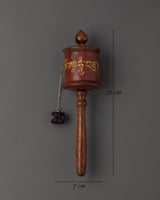
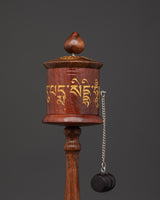
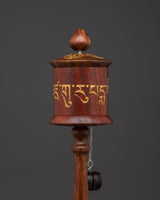
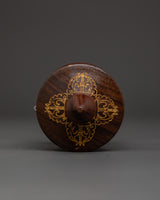
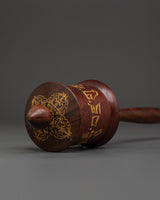
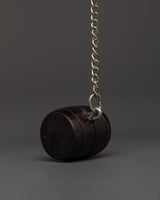


Handcrafted Wooden Prayer Wheel | Tibetan Mantra Spinner

100% AUTHENTIC

HANDMADE

FREE SHIPPING
Tibetan Handcrafted Wooden Prayer Wheel | Sacred Spinner for Meditation, Blessings & Spiritual Practice
--------------------------------------------------------
Size: 28cm (Height) x 7cm (Width)
Weight: 0.24kg
Materials: Wooden Body, Acrylic Color
--------------------------------------------------------
About our Prayer Wheel
This handcrafted wooden prayer wheel is 28cm tall and 7cm broad, made of wood with a mantra inscription. The "Om Mani Padme Hum" chant arcs around the wheel, emphasizing its holiness. A weighted striker paired to a chain facilitates its smooth rotation, making it suitable for use in personal or group meditation.
The natural wood finish, mixed with acrylic color, gives this item an attractive but grounded appearance. It's lightweight yet powerful, making it an excellent choice for home altars, meditation spaces, or as a thoughtful gift. This prayer wheel is not only a lovely decorative piece, but it is also a powerful spiritual tool to cultivate compassion and mindfulness.
This wooden prayer wheel is ideal for anyone wishing to enhance their meditation practice or deepen their connection to Tibetan Buddhism. It provides blessings and calm wherever it is used. Its traditional design incorporates respect for historical traditions while seamlessly blending with contemporary spiritual practices.
Introduction to Prayer Wheel
A prayer wheel is cylindrical on a spindle and is used in Tibetan Buddhism. It is typically inscribed with the mantra "Om Mani Padme Hum" and rotated by hand as a form of spiritual practice and to accumulate merit. Spinning the wheel is believed to have the same spiritual benefits as verbally reciting the mantra. The use of prayer wheels is widespread in Tibetan Buddhism and has spread to other cultures.
How does the Buddhist Prayer Wheel benefit us?
The benefits associated with rotating the wheel are numerous. It promotes knowledge, compassion, and bodhicitta in the practitioner and improves siddhis (spiritual powers such as clairvoyance, precognition, etc.). The practitioner can repeat the mantra as often as possible while the wheel is rolling, maintaining a calm, meditative attitude. A Tibetan Buddhist tradition holds that after a practice session, one should dedicate any acquired merits to the benefit of all sentient beings. Then three times Om Ah Hum. This is usually among Tibetans after finishing any Buddhist practice, including the prayer wheel exercise.
How do you set up your own Buddhist Shrine?
• Find a clean, quiet, and uncluttered spot
• Set up an altar table and cover it with an altar cloth that calls to you
• Place your sacred item at the center
------------------------------------------------------------------



















